Hinduism
Chiranjivis: The Eight Divine Immortals of Hinduism
Published
5 years agoon
By
Vedic Tribe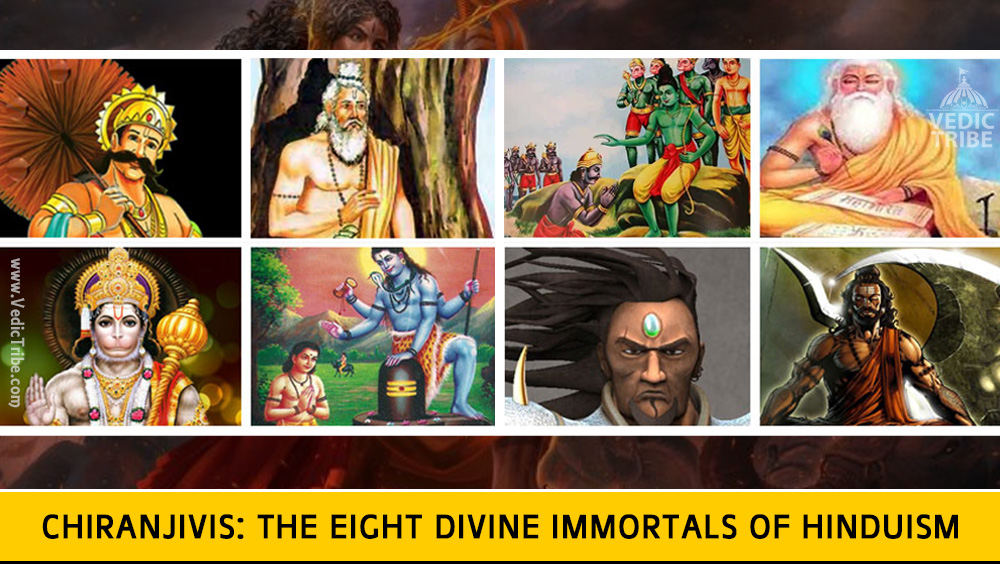
Chiranjivi are permanent lived beings in Hinduism who are to remain alive through this Kali Yuga until the next Satya Yuga. The term is a combination of chiram, or ‘permanent’, and jīvi, or ‘lived’. It is same as’amaratva, which refers to true immortality.
At the end of the last Kalpa, a demon attempted to become immortal by swallowing the Vedas as they escaped from the mouth of Brahma. The scripture was retrieved by the first avatar of Vishnu, Matsya. Incarnations of Vishnu also later fought and killed two other asuras, Hiranyakasipu and Ravana, who tried to become immortal through obeisance to Shiva. In Hinduism, immortal does not mean eternal, as all physical bodies are foretold to become immaterial at the end of time, along with Brahma himself.Puranas, the Mahabharata and the Ramayana describe eight long lived personalities in the Hindu pantheon. They existed in past ages, Satya Yuga, Treta Yuga, and Dvapara Yuga, and are alive today in our current Kali Yuga. Each represents a different attribute of man, which as long as they live, will exist amongst humanity.
The chiranjivi are as follows
Markandeya
An ancient sage from the Hindu tradition, born in the clan of Brigu Rishi. He is celebrated as a devotee of both Shiva and Vishnu and is mentioned in a number of stories from the Puranas.
The Markandeya Purana especially, comprises a dialogue between Markandeya and a sage called Jaimini, and a number of chapters in the Bhagavata Purana are dedicated to his conversations and prayers. He is also mentioned in the Mahabharata. Markandeya is venerated within all mainstream Hindu traditions.
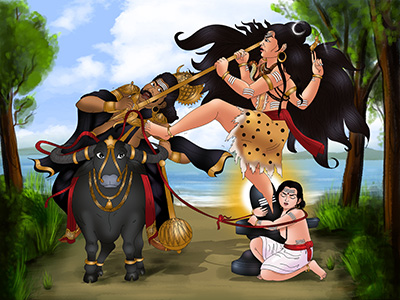
Mrikandu rishi and his wife Marudmati worshipped Shiva and sought from him the boon of begetting a son. As a result he was given the choice of either a gifted son, but with a short life on earth or a child of low intelligence but with a long life. Mrikandu rishi chose the former, and was blessed with Markandeya, an exemplary son, destined to die at the age of 12.
Markandeya grew up to be a great devotee of Shiva and on the day of his destined death he continued his worship of Shiva in his aniconic form of Shivalingam. The messengers of Yama, the god of death were unable to take away his life because of his great devotion and continual worship of Shiva. Yama then came in person to take away Markandeya’s life, and sprung his noose around the young sage’s neck. By accident or fate the noose mistakenly landed around the Shivalingam, and out of it, Shiva emerged in all his fury attacking Yama for his act of aggression. After defeating Yama in battle to the point of death, Shiva then revived him, under the condition that the devout youth would live forever. For this act, Shiva was thereafter known also as Kalantaka (“Ender of Death”).
Thus Maha Mrityunjaya Stotra is also attributed to Markandeya. The Devi Mahatmya section of the Markandeya Purana is one of the most important texts of Shakti tradition.
Ashwatthama
The son of Drona, a great warrior. He acted out of cowardice to avenge the killing of his father, resulting in a curse of immortality.
Since Hastinapur, ruled by King Dhrishtrastra, offered Dronacharya the privilege of teaching the Kuru princes, both Dronacharya and Ashwatthama were loyal to Hastinapur and fought for the Kauravas in the Kurukshetra war.
On the last night of the war after Duryodhana’s defeat, a very disturbed and restless Ashwatthama was sitting sleepless under a large tree. An owl caught his attention. He observed that an owl was being attacked and harassed by crows in the morning. This owl attacked the same group of crows at night. This gave him an idea of attacking the Pandava camp at midnight. He gathered the only other surviving Kaurava warriors—Kritavarma and Kripacharya and attacked the Pandava camp on the 18th night of the Kurukshetra war. He killed Dhrishtadyumna, Shikhandi and many other prominent warriors of Pandava army while they were sleeping. Those who tried to flee from Ashwatthama’s wrath, were hacked down by Kripacharyya and Kritavarma who were positioned at the camp’s entrance. He killed Draupadi’s five sons, the Upapandavas, while they were sleeping believing them to be the five Pandava brothers.

After destroying the entire Pandava camp, Ashwatthama carried the five heads of Draupadi’s sons and proceeded towards Duryodana claiming that he had beheaded the Pandavas. When he realized his mistake, Ashwatthama went to Sage Vedavyasa’s ashram in order to seek salvation for his crime.
The Pandavas and Krishna who were away during night, now returned to their camp the next day morning. Incensed over this cowardly act of Ashwatthama, the Pandavas went after him to sage Vyasa’s ashram. On seeing the approaching angered Pandavas, Ashwatthama who learnt that he had killed the upapandavas and not the Pandavas, realised that he was trapped with the Pandavas. As a last resort, he used his sacred knowledge of the Vedas to devise a Bramhashirastra from a blade of grass and invoked it against the Pandavas and Krishna, although he was strictly forbidden to do so by his father Dronacharya for any purpose whatsoever. On seeing the Brahmashirastra approaching the Pandavas, Krishna asked Arjuna to invoke the same. Arjuna invokes Bramhashirastra, which he received by Dronacharya himself, towards Ashwatthama.
On seeing the two powerful astras heading for a head on cataclysmic (catastrophic) collision that would result in the total annihilation of the entire Earth, sage Vyasa stopped these divine weapons from colliding with each other by using his yogic power. He asked both these warriors to withdraw their respective weapons. Arjuna was able to withdraw his Brahmashirastra, while Ashwatthama could not do so as Dronocharya did not teach his son how to withdraw it. An archer who is able to invoke and withdraw any Divyastra (Divine Weapon) can invoke it as many times as he wishes. Dronacharya taught Arjuna to withdraw Brahmashirastra but he did not do so to Ashwathama, thus limiting the power of Ashwathama to invoke Brahmashirastra for only one instance.
However, Ahswathama was given the option of deviating his weapon towards one single isolated object in a place that was not inhabited by any form of life, so that the Brahmashirastra does not harm anyone on Earth. But Ashwatthama, out of spite, directed the weapon towards the womb of Uttara (wife of Abhimanyu) who was carrying Abhimanyu’s son (Parikshit) in an attempt to end the lineage of the Pandavas. Krishna used his sudarshana chakra to stop the Brahmashirastra and save Uttara’s unborn child.
Angered by this cowardly act, Lord Krishna placed a curse on Ashwatthama that “he will carry the burden of all people’s sins on his shoulders and will roam alone like a ghost without getting any love and courtesy till the end of Kaliyuga; He will have neither any hospitality nor any accommodation; He will be in total isolation from mankind and society; His body will suffer from a host of incurable diseases forming sores and ulcers that would never heal”.
Ashwatthama had a gem which was similar to Shamantakamani on his forehead which used to protect the wearer from fear of any snakes, ghosts, demigods and demons. So, Ashwatthama was asked to surrender this gem. Lord Sri Krishna further states that “the wound caused by the removal of this gem on his forehead will never heal and will suffer from leprosy, till the end of Kaliyuga”. It is believed that in Kaliyuga, his name will be “Suryakanta”. Thus, Ashwatthama will be in search of death every moment, and yet he will never die. At the end of Kali Yuga, Ashwatthama is to meet Sri Kalki, the tenth and final avatar of Lord Vishnu.
Bali Chakravarthi
Granted a boon by Vishnu that he would be the next Indra, before merging with Vishnu, Bali expounds virtues of valour and charity.
Bali, an asura, was the son of Devamba and Virochana. He grew up under the tutelage of his grandfather, Prahlada, who instilled in him a strong sense of righteousness and devotion. Bali would eventually succeed his grandfather as the king of the Asuras, and his reign over the realm was characterized by peace and prosperity. He would later expand his realm – bringing the entire world under his benevolent rule – and was even able to conquer the underworld and Heaven, which he wrested from Indra and the Devas. The Devas, after their defeat at the hands of Bali, approached Vishnu and entreated him to restore their lordship over Heaven.
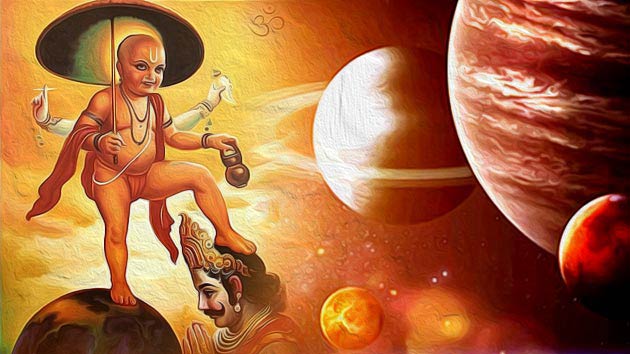
In Heaven, Bali, on the advice of his guru and advisor, Sukracharya, had begun the Ashwamedha Yagya so as to maintain his rule over the three worlds. Vishnu, meanwhile, had adopted the avatar of Vamana, a small Brahmin boy, and, during the rite, approached Bali and requested a grant of land – although only as much land as he could cover with three paces. Despite the warnings of his advisor, Bali granted this boon. Vamana then grew to an immense size, and, with his first pace, traversed the all of the earth and the underworld. With his second pace, he covered Heaven in its entirety. Admitting defeat, and seeing that Vamana has no more room for his last step, Bali offered his own head as a stepping-stone. At this time the asuras spoke out in protest, but Bali silenced them. He explained that all living and non living things are of His creation, and so it was His right to have them back. Lord Vishnu, seeing the devotion of Mahabali, blessed him and raised to him to Suthala, the supreme position in heaven.
Hanuman
As an avatar of Shiva who served Rama, Hanuman stands for selflessness, courage, devotion, strength, and righteous conduct.
As an ardent devotee of Lord Rama, Hanuman is the central character in the Indian epic Ramayana. He also finds mentions in several other texts, including Mahabharata, the various Puranas and some Jain texts. A vanara (ape-like humanoid), Hanuman participated in Rama’s war against the demon king Ravana. Several texts also present him as an incarnation of Lord Shiva. He is also considered the son of Vayu, who according to several stories, played a role in his birth.
Shortly after he is crowned Emperor upon his return to Ayodhya, Rama decides to ceremoniously reward all his well-wishers. At a grand ceremony in his court, all his friends and allies take turns being honoured at the throne. Hanuman approaches without desiring a reward. Seeing Hanuman come up to him, an emotionally overwhelmed Rama embraces him warmly, declaring that he could never adequately honour or repay Hanuman for the help and services he received from the noble Vanara. Sita, however, insists that Hanuman deserved honour more than anyone else, and Sita gives him a necklace of precious stones adorning her neck.

When he receives it, Hanuman immediately takes it apart, and peers into each stone. Taken aback, many of those present demand to know why he is destroying the precious gift. Hanuman answers that he was looking into the stones to make sure that Rama and Sita are in them, because if they are not, the necklace is of no value to him. At this, a few mock Hanuman, saying his reverence and love for Rama and Sita could not possibly be as deep as he implies. In response, Hanuman tears his chest open, and everyone is stunned to see Rama and Sita literally in his heart.
After the war, and after reigning for several years, the time arrived for Rama to depart to his supreme abode Vaikuntha. Many of Rama’s entourage, including Sugriva, decided to depart with him. Hanuman, however, requested from Rama that he will remain on earth as long as Rama’s name was venerated by people. Sita accorded Hanuman that desire, and granted that his image would be installed at various public places, so he could listen to people chanting Rama’s name. He is one of the immortals (Chiranjivi) of Hinduism.
According to legend, Hanuman is one of the four people to have heard the Bhagwad Gita from Krishna and seen his Vishvarupa (universal) form, the other three being Arjuna, Sanjaya and Barbarika, son of Ghatotkacha.
Kripa
Also known as Kripacharya, he was military guru of the princes in the Mahabharata.
He fought in the great battle of Kurukshetra for the Kaurava side. Afterwards, he was appointed to be the teacher and preceptor of Parikshit, the grandson of Arjuna. He was known for his impartiality and loyalty for his Kingdom.
He is one of the immortals who are to remain alive throughout the present age, the Kali Yuga.
Parashurama
The 6th avatar of Vishnu, Parashurama was the master of all astras, sastras and divine weapons.

Parashurama is unique in that although he is the sixth avatar of Vishnu, as an immortal, he has also lived to see the subsequent incarnations of Vishnu in Rama, Krishna and Buddha. Parashurama played an important role in both the Ramayana and Mahabharata.
The Kalki Purana writes that he will re-emerge at end time to the martial guru of Kalki. He will then instruct the final avatar to undertake penance to receive celestial weaponry, required to save mankind at end time.
Vibhishana
Younger half-brother of Ravana, though a Rakshasa himself, Vibhishana was of a noble character and advised Ravana, who kidnapped and abducted Sita, to return her to her husband Rama in an orderly fashion and promptly. When his brother did not listen to his advice, Vibhishana joined Rama’s army.
In the Lanka War, Vibhishana’s knowledge about the secrets of Lanka proved invaluable to Shri Rama. Vibhishana freely divulged many secrets that became key to the success of Rama’s attack, including revealing the secret path to the temple of Mata Nikumbala, the family deity of the Pulatsya Clan. Because of this, however, Vibhishana is also known as a traitor.
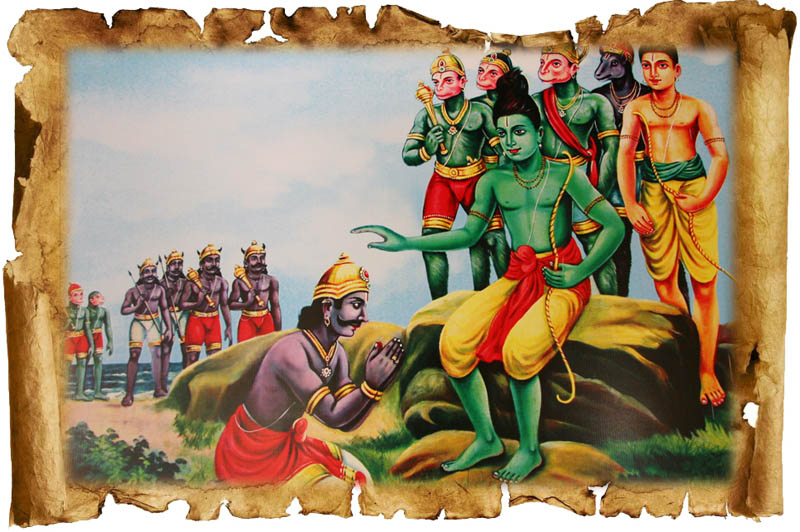
Later, he was crowned king of Lanka after Ravana was killed by Rama and turned his subjects from the path of evil to the path of Dharma (righteousness). He stands for righteousness. When Shri Rama was about to leave Ayodhya at the end of his reign, Lord Rama in his original form of Shri Vishnu ordered Vibhishana to stay on earth and serve the people and guide them to the path of truth and Dharma.
Vibhishana is not a true Chiranjeevi, as his boon of longevity is to remain on the earth only until the end of Treta Yuga.
Rishi Veda Vyasa
A sage who narrated the Mahabharata, he is also known as Veda Vyasa or Krishna Dvaipayana. He was the son of Rishi Prashar and grandson of Rishi Vashist, he represents erudition and wisdom. He is the author of the Mahabharata, as well as a character in it and is considered to be the scribe of both the Vedas and Puranas.
Vyasa’s Jaya, the core of Mahābhārata is structured in the form of a dialogue between Dhritarashtra (the Kuru king and the father of the Kauravas, who opposed the Pāndavas in the Kurukshetra War) and Sanjaya, his advisor and chariot driver. Sanjaya narrates each incident of the Kurukshetra War, fought in 18 days, as and when it happened. Dhritarāshtra sometimes asks questions and doubts and sometimes laments, knowing about the destruction caused by the war, to his sons, friends and kinsmen.
Rishi Veda Vyasa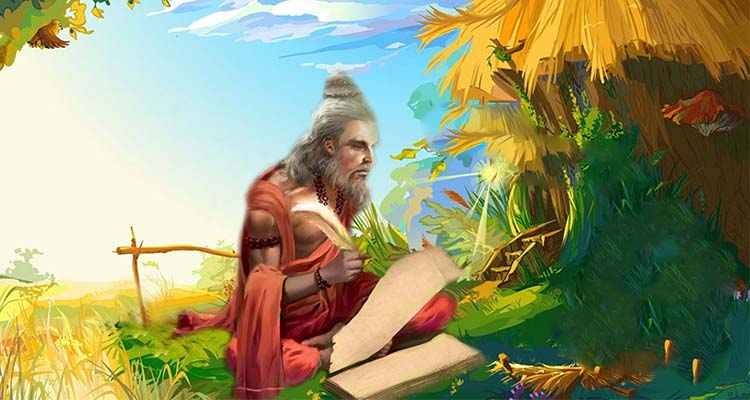
In the beginning Sanjaya gives a description of the various continents of the Earth, the other planets, and focuses on the Indian Subcontinent and gives an elaborate list of hundreds of kingdoms, tribes, provinces, cities, towns, villages, rivers, mountains, forests etc. of the (ancient) Indian Subcontinent (Bhārata Varsha). He also explains about the ‘military formations adopted by each side on each day, the death of each hero and the details of each war-racings.
Some 18 chapters of Vyasa’s Jaya constitute the Bhagavad Gita, the sacred text of the Hindus. Thus, this work of Vyasa, called Jaya deals with diverse subjects like geography, history, warfare, religion and morality.
The festival of Guru Purnima is dedicated to him. It is also known as Vyasa Purnima for it is the day believed to be both his birthday and the day he divided the Vedas into four parts.
Vyasa was born in almost last of Treta Yuga, lived to see the whole Dwapar Yuga and Kalyuga. Greatly disturbed by the violence in today’s world, he is said to have retreated from society into some remote village in Northern India.
You may like
-


Seven Vows and Steps (pheras) of Hindu Wedding explained
-


Atithi Devo Bhava meaning in Hinduism and India
-


Navaratri: The Nine Divine Nights of Maa Durga!
-


History of Vastu Shastra
-


Significance of Bilva Leaf – Why is it dear to Lord shiva?
-


Concept of Time and Creation (‘Brahma Srishti’) in Padma Purana
Hinduism
Significance of Bilva Leaf – Why is it dear to Lord shiva?
Published
5 years agoon
March 12, 2021By
Vedic Tribe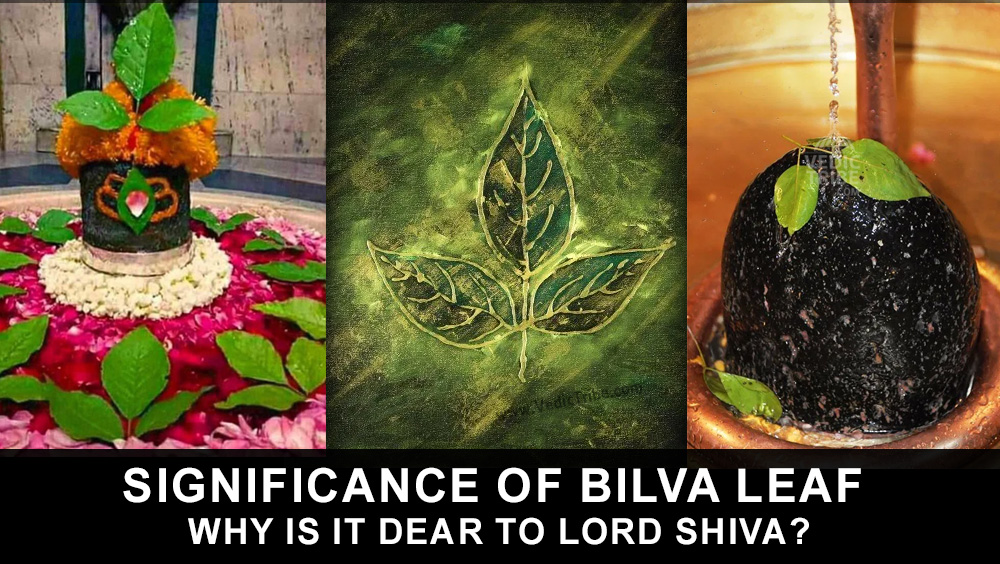
– Arun Gopinath
Hindus believe that the knowledge of medicinal plants is older than history itself, that it was gifted hundreds of thousands of years ago to the Vedic by Lord Brahma, the divine creator.
Thus when the Rishis of the Ayurveda sought to heal human suffering, they were able to draw on knowledge that had already been evolving for millennia in the forests of India. One tree about which they had a very deep knowledge was the Bilva tree. The science of Ayurveda values the Bilva highly for the medicinal properties contained in its root, fruit and leaves. According to Swami Sivananda, it is a healing tree which cures all diseases caused by vata (wind) and gives strength to the body.
More commonly known as the Bel Tree in India as well as other warm countries, this is a sacred tree having sacrificial importance and the first thing we can notice about the leaves is that they are generally trifoliate. This trifoliate leaf is symbolic of Trikaal or the Hindu Trinity of Devas known as Brahma Vishnu and Mahesh. The other names of this tree are Wood apple and its botanical name is Aegle marmilos.
The Bilva leaf or Patra as it is known, represents the Trinetra or three eyes of Lord Shiva, the main aspects like Trishakti (volition, action and knowledge), the three Shiva lingams and the three syllables of AUM or Omkar and are most favorite of Lord Shiva.
There are also five formed Bilva leaves known as PanchaDal patra found on some Bilva trees and these too are held as sacred for the worship of Lord Shiva. Bilva tree grows to a height of 8 meters with thorns. The leaves are alternate, ovate, trifoliate and aromatic. The tender leaves and shoots are consumed as salad greens. The flowers bloom in the month of May and will have a sweet fragrance.
It appears from all the Hindu texts and scriptures that the Bilva tree itself has been held very sacred and auspicious and is considered very holy since time immemorial thats its significance is mentioned in Mahapuranas in various forms of mantras. The Shiva Purana mentions a particular narration of how the usage of Bilva due to its scientific as well as medicinal properties is of great adavantage to Mankind.
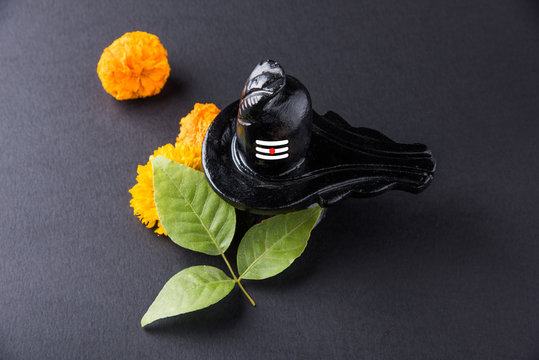
The 22nd Chapter of maha ShivaPurana narrates ” The trifoliate Bilva Patra is so sacred to Lord Shiva & is therefore a symbol of the Lord. Adored by all the Gods, its importance is difficult for anyone to comprehend. The sacred tree can only be known to a limited extent. Sacred sites of this Earth can only find their place at the root of this auspicious tree. Those who meditate upon Lord Mahadeva in His form of linga at the root of Bilva obtain Moksha & become purified souls by attaining Shiva. Such are the marvels of this sacred Bilva.”
The famous Shri Bilvashtakam (v. 6–7) Mentions :
Lakshmyaascha stana utpannam Mahaadeva sadaa priyam,
Bilva vriksham prayachchhaami eka bilvam Shivaarpanam.
Darshanam bilva vrikshasya sparshanam paapanaashanam,
Aghorapaapasamhaaram eka bilvam shivarpanam.
Translation :
Born from the heart of Goddess Lakshmi, the Bilva tree is ever dear to Mahadeva. So I ask this tree to offer one Bilva leaf to Lord Shiva. Even if (one) has darshan ( view) of the Bilva tree, and touches it, surely frees one from sin. The most terrible karma is destroyed when a Bilva leaf is offered to Lord Shiva.
It is also believed that Lakshmi, the Goddess of Wealth, also lives in the bel tree. Those who perform the puja of Shiva and Parvati devoutly, using the leaves, will be endowed with spiritual powers.
Scientific Advantages
According to Hindu scriptures, the Bilva is Triguna which is connected to the three Gunas or components of natural characteristics of the tree. In Hindu philosophy, the three Gunas are Sattva, Rajas & Tamas with Sattva being the pure most while Tamas normally is to do with darkness & ignorance.
The Sattvic component is believed to be more centered within the bilva patra and therefore the high capacity to absorb and emit Sattvic frequencies. This has various effects on the environment as well as on anyone merelt touching the leaf. One of them is the reduction of Rajasic-Tamasic atoms present in the atmosphere & more importantly within the human body.
A Sattvic leaf like bilva patra when brought in proximity of a person suffering from negative energies such as distress and anxiety is believed to medically reduce these energies within the human body. People with negative outlook towards life and their environment normally do not realize they have negative energies building up within their body and are at a risk of subconsciously harpering destructive thoughts also.
Whenever such people come into contact with a Sattvic atmosphere, what they fail to realize is their negative energies try to fight the positivity of a Sattva predominant environment. This struggle can build up at various levels and can vary from the human mind thinking negatively and can result sudden bursts of anger to destruction of things around them.
Medicinal uses
The roots, skin, fruits and the leaves of the Bilva tree are used for medicinal purpose. Bilva has astringent, edema lessening, anti-diarrhea, laxative and appetizer properties hence, can be used to cure both internal and external diseases.
The sacred tree has many medicinal usages and is advantageous in curing many human ailments such as :
- Bleeding gums.
- Bel fruit clears diarrhea, dysentry, phlegm, high blood pressure, morning sickness in pregnancy, stress.
- Asthma can be controlled when a mixture of dry bel leaf powder & honey is consumed daily
- Jaundice can be cured by consuming the extracted juice of the bilva leaves
- Anemia can be cured by drinking the powder of the bel fruit mixed with milk
- Bel fruit keeps the skin rejuvenated when pasted into a face pack; also cures joint aches
Hinduism
Concept of Time and Creation (‘Brahma Srishti’) in Padma Purana
Published
5 years agoon
March 12, 2021By
Vedic Tribe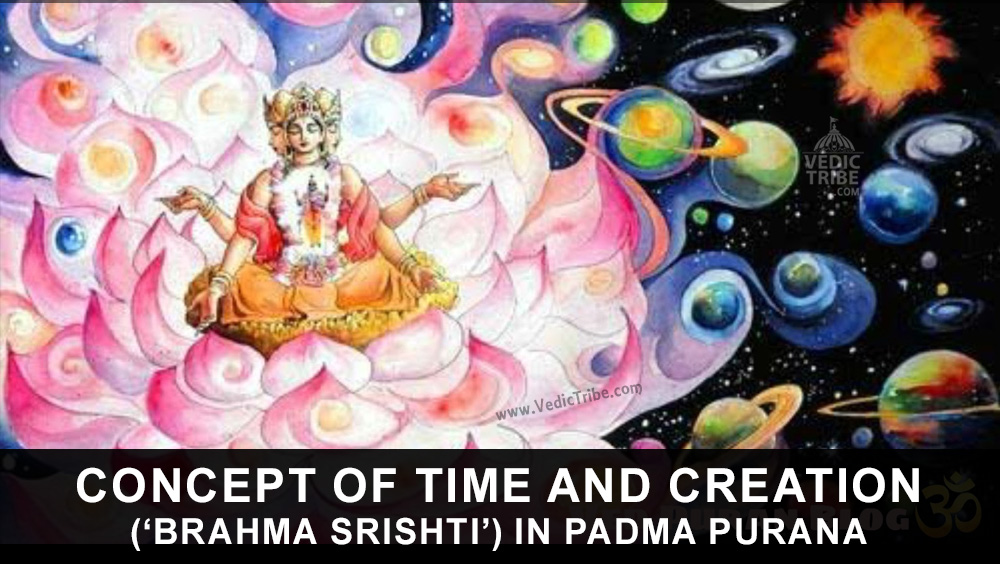
Pulastya Maha Muni affirmed to Bhishma that Brahma was Narayana Himself and that in reality he was Eternal. But in a formal sense it was stated that Brahma was ‘created’ and in that normally recognised manner Brahma had hundred years of age; apparently, the concept of Time would have to have a basis and that was why Brahma’s age was determined notionally as of hundred Brahma Years; in other words, ‘Para’or the first half was over and his present age has entered the ‘Paraartha’, the second half (viz. Fifty first year).This was how, the concept of Time emerged.
Every fifteen ‘Nimeshas’ constitute one ‘Kaashtha’; thirty Kashthas one one ‘Kala’; thirty Kalas make one ‘Muhurtha’; thirty Muhurtas make one day/night, thirty day/nights make on ‘Maasa’; (half Maasa makes one ‘Paksha’), six Maasas make one ‘Ayana’ and two Ayanas-Dakshinayana and Uttarayana- make one ‘Year’. Dakshinayana is a night for Devas and Uttarayana their day. One hundred human years make one day-night of Devas.
Twelve thousand Deva Years make four Yugas viz, Satya Yuga, Treta Yuja, Dwapara Yuga and Kali Yuga and these four Yugas make one Maha Yuga which is Brahma’s one day! Satya Yuga comprises 4800 DevaYears including ‘Sandhya mana’ of 400 years and ‘Sandhyamsha maana of additional 400 years; Treta Yuga comprises 3600 Deva Years including 600 years of ‘Sandhya/ Sandhyamsha mana’each; Dwapara Yuga of 2400 years including 200 years of ‘Sandhya/ Sandhyamsha mana’each and Kali Yuga of 1000 years including 100 years each of Sandhya / Sandhyamsha manas.Deva Years are 360 times more than human years. For instance, the duration of Kali Yuga in human year terms is 432,000 years; Dwapara’s is 864000; Treta Yuga’s is12, 96,000 and of Satya Yuga is 17, 28,000 years; all the Yugas totalling 432, 00, 00,000 (432 million) make one Chaturyuga and that constitutes one Brahma Day!
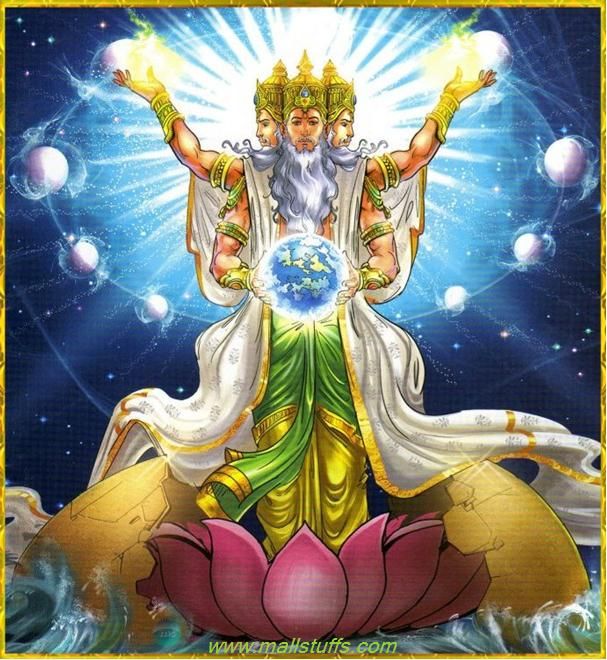
In one day of Brahma there are fourteen Manvantaras and each Manvantara has 8, 51,000 of Deva Years. There are two kalpas on one day-night of Brahma.At the end of the previous Kalpa, Brahma felt fresh from the previous night and found that Prithvi was submerged in water while Bhagavan Varaha Deva entered into water and Prithvi prayed to him; in response, Varahadeva emanated a ‘Ghur Ghur’ sound which was like the reverberation of Sama Veda, lifted up Prithvi from Rasala loka by the might of his horns, Devas rained fragrant flowers from the sky, Rishis went into rapturous tributes to Vishnu’s incarnated Varaha Rupa; and Brahma implored the latter to allow him recommence Srishti with his blessings as also to preserve and administer the Creation that he would so generate even as the Lord gracefully replied to say: ‘Tathastu!’ (So be it!).
Brahma’s first Srishti being Maha Tatva, the creation of Tanmatras was known as Bhuta Sarga or the Second Srishti; Vaikarika or Satvika Ahankara was the third Srishti of Indriyas or Aindriya Sarga; the Fourth Srishti is the Mukyha Sarga related to Mountains, Forests and other Sthaavara Srishti; the fifth Srishti relates to Pashu-Pakshi (Animals and Birds); the seventh Srishti was called Deva sarga or Urthva faced and was of Devas; and Seventh Srishti was of Manava Sarga; the Eighth was of Anugraha Sarga which could be of Satvika or Tamasic nature and finally the Ninth Srishti called the Kaumara Sarga which could be of Prakrita or Vaikrita Marg.
Depending on the carry forward of one’s own balance of ‘Papa-Punya’of the previous time-frame preceding the Pralaya, placement of lives was commenced by Brahma in the New Age. Arising out of his ‘Manasika Samkalpa’ (Mind born Proposal), Brahma created various species including Devas, Asuras, Pitaras and human beings. From his thighs, the evil Asuras emerged and as per his free will various birds were created.
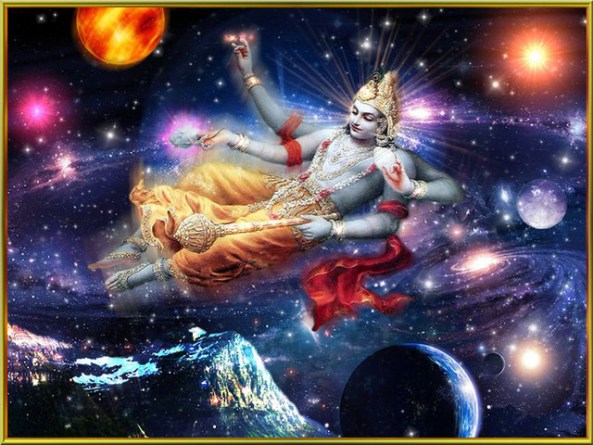
From his stomach surfaced cows, his shoulders the wolves; his face created horses, elephants, asses, nilgais, deer, camels, etc.each species multiplying several others. Brahma’s body hairs created fruits, roots and foodgrains. From his right extreme face, Brahma created, Gayatri Chhandah, Rig Veda, Tivritstoma, Rathantara, Agnihoshtha yagna; from South-faced he created Yajur Veda, Tristhub Chandas, Panchadasha stoma, Brihatsaama, etc; Sama Veda, Jagati Chhanda, Saptadashastoma, ‘Vairupa’ etc; from the Western face; Brahma created Ekavimshatstoma, Atharva Veda, Aptoryama, Anushthup chhanda, and Vairaja from the Uttaravarti Mukha. Miscellaneous ‘Pranis’ were created from any of the limbs of Brahma. To sum up thus at the beginning of the Kalpa, Prajapati Brahma created Devas, Asuras, Pitaras and human beings as also of Yakshas, Pishachas, Gandharvas, Apsaras, Siddhas, Kinnaras, Raakshasaas, Lions, Birds, Animals and Reptiles.
Focussing attention on human beings now, Bhishma asked the highlights of Varnashrama Vidhi and Pulastya Muni explained that Brahma created Brahmanas from the face, Kshatriyas from ‘Vakshasthali’ (chest), Vaishyas from thighs; and Shudras from the feet.These four Varnas are the important constituents of ‘Yagnas’; Devas are satisfied wirh their respective portions of ‘Havis’ (oblations) to Agni and being pleased with the Yagnas, Devas bestow good rains and good crops which leads to material prosperity.
The hearts and hands of every body tend to be clean and social customs and virtuous living would go hand in hand. Prajapati decided the duties of the Four Varnas, depending on the professions that human beings tended to follow like Brahmanas performing Yagnas, Vratas, Temple Tasks, and enabling various religious deeds of Virtue in favour of the members of three other Varnas etc.; Kshatriyas discharging the responsibilities of Kingship, Administration, Security against external enemies, collection of taxes and maintenance of Internal Law and Order; Vaishyas performing business, farming, trading and all matters involving finance, provision of materials to others by allowing reasonable profits for the services given etc. and Shudras supporting the members of the Three Varnas in the discharge of duties being undertaken by them.
Brahma materialised the above various kinds of Creations by applying his mental faculties but was not quite satisfied as the next generations so created were not adequate to fill in the universe; therefore he created Sages like Bhrigu, Pulaha, Kratu, Angira, Marichi, Daksha, Atri and Vasishtha, in addition to the four ‘Manasa Putras’ viz. Sanaka, Sanandana, Sanatana and Sanat Kumaras. As not all these sons were interested in family lives, Brahma created Rudra from his forehead and decided that half of the body be a woman; thus Eleven Rudras got materialised along with as many Rudranis who had a variety of Rupas ranging from ‘Sowmya’ (composure), ‘Krura’(unkindness), ‘Shanta’ (peacefulness), ‘Shyama’ (darkness), ‘Gaura’ (wheatish) and such other colours.
Further on, Brahma created Swayambhu Manu and the latter’s wife Shatarupa; the Manu couple gave birth to sons Priyavrata and Uttanapada and daughters Prasuti (married to Daksha) and Akruti (married to Ruchi Prajapati). To Prasuti and Daksha were born twenty four daughters, thirteen of whom were Shraddha, Lakshmi, Dhruti, Pushti, Tushti, Megha, Kriya, Buddhi, Lajja, Vapu, Shanti, Sidhi, and Kirthi (all these thirteen were married to Dharma); eleven more daughters were Khyati, Sati, Sambhuti, Smriti, Preeti, Kshama, Sannati, Anasuya, Urja, Swaha and Swadha; they were wedded respectively to Bhrigu, Shiva, Marichi, Angira, Pusasthya, Kratu, Atri, Vasishtha, Agni and Pitras.
The sons of Daksha’s daughters were Kamak by Shraddha, Darpa to Lakshmi, Niyam to Dhriti, Santhosh to Tushti, Lobha to Pushti, Shruta to Megha; Danda, Vinay and Naya to Kriya, Bodha to Buddhi, Vinay to Lajja, Vyavasayak to Vapu, Kshema to Shanti, Sukha to Siddhi, and Yash to Kirti.These were all the sons of Dharma. Kaam and Nandi gave birth to Harsha, the grand son of Dharma. Bhrigu and Khyati gave birth to Devi Lakshmi who was Lord Narayana’s wife. Bhagavan Rudra accepted Sati as his wife (Daksha’s daughter) but Devi Sati sacrificed her life pursuant to Daksha’s Yagna to which Rudra was uninvited but Sati insisted in attending it; she felt highly insulted by her father Daksha who also offended Rudra Deva and Rudra eventually destroyed Daksha Yagna. — with Srilan Srisukumaran.
Hinduism
Karma Yoga – Yog Through Selfless Actions
Published
5 years agoon
February 23, 2021By
Vedic Tribe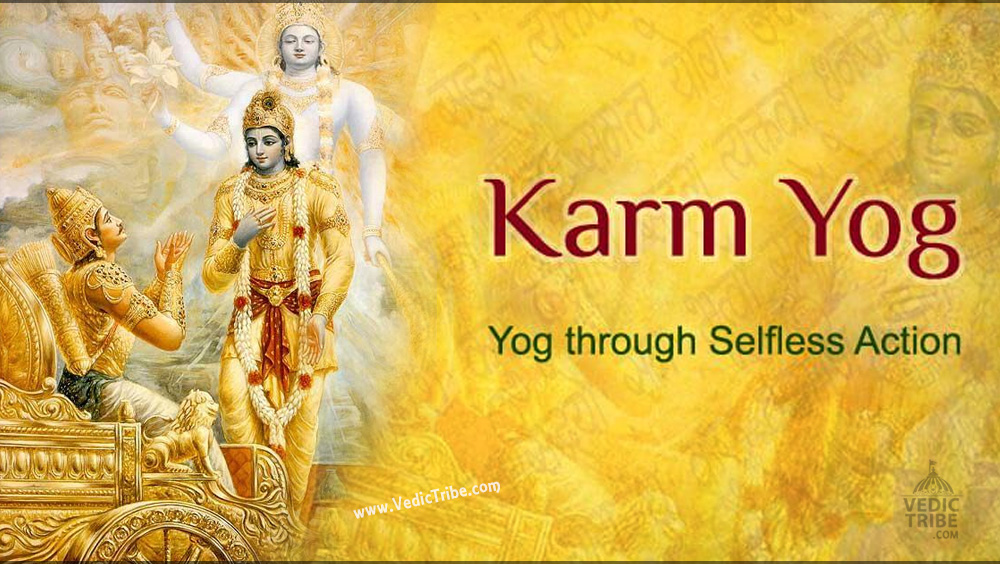
Karma Yoga is Meditation in Action:
“Karma” means action and “yoga” means loving unity of our mind with God. To perform karma and also practice yoga means to remain engaged in activity in the world while remaining in a state of devotional unity with God. This is true spiritual action.
Your bhakti yoga meditation practice will combine all these aspects and it will include:
- Daily sitting meditation
- Daily dynamic meditation woven seamlessly into the fabric of your life’s activities
Before we look at guidelines for these, let’s explore how process is described in the Hindu scriptures.
Karma Yoga of the Bhagavad Gita:
One of the most important scriptures of Hinduism, the Bhagavad Gita, was revealed under unusual circumstances: moments before a war and in the middle of a battlefield. It is comprised of a 700-verse dialogue between Lord Krishna, supreme God, and Arjuna, his loving disciple.
The all-in-one solution of the Bhagavad Gita for eliminating karma is Lord Krishna’s advice to practice akarma or actions that have no karmic consequence.
If we could perfect akarma in daily activity, the consequences of our actions would automatically be neutralized — even though we are engaged in action.
This means that from the point of view of karmic debt, no consequences would be added to our “account”. The only key to this is we must maintain an unbroken and continuous devotion to God.

Karma yoga philosophy in the Bhagavad Gita is summed up in one statement of Lord Krishna:
“Remember Me and fight.”
But is it really possible to simultaneously do devotional remembrance and be engaged in activity? Can the mind function in two places at the same time? This is definitely impossible, but for karma yoga to be done properly, both have to happen simultaneously.
For example, if you are at work and absorbed in a project, and remember God occasionally, how are both these actions accounted for as karmas?
The time you spent in devotional remembrance will be considered devotional action, and the time you spent engrossed in working will be considered normal action. This is not karma yoga.
Plus, a common misconception describes karma yoga as “performing action without being attached to the results”. Although this sounds noble, is it psychologically possible for any human being to do this?
The fact is because we are constantly trying to find authentic happiness, we will always anticipate the outcome of our actions in advance of doing them.
The practical form of the Gita’s karma yoga…
In the Gita, Krishna was both supreme God and Arjuna’s spiritual guide. Krishna advised Arjuna to surrender to Him and to simply follow His instructions. By transferring his motivation for action to a divine personality, Arjuna would not be responsible for the outcome of the actions he was instructed to perform.
For example, a police officer is issued a revolver, which he is instructed to use in the line of duty by his superiors. It could happen that he kills someone in the pursuit of law and order. In the eyes of the justice system, this will not be considered a crime. He did not use his own mental motivation to decide to kill someone — he simply followed the guidelines given to him by his superiors.
In Arjuna’s situation, in spite of engaging in war, all his actions were counted as devotion, because his heart, mind and body were fully dedicated to the will of Krishna.
This again highlights one of the most important points of karma yoga: The mind is the performer of action, not the physical body.
It is our personal motive that has to be carefully redirected for karmic consequences to change or be neutralized.

A Closer Look at the Spiritual Theory
If a practitioner is surrendered to a true divine Guru, and performs actions entrusted to him by his Guru, that activity is considered not only karma yoga, but also bhakti or spiritual action. It will be free of a karmic consequence. That practitioner is not directly attached to the results of that activity because his motive is to follow the instructions of his Guru.
Arjuna accepted Lord Krishn as his Guru at the very beginning of the Gita when he declared he was Lord Krishna’s disciple. He preserved the understanding during the entire Mahabharata War that he was doing service for his Guru.
In this way, just by holding this intention, his devotion remained unbroken and his actions were considered karma yoga. Thus, service to a true Guru is called karma yoga or devotion.
Practically speaking, a Guru will give instructions on how a practitioner can keep his mind engrossed in a state of continuous devotional remembrance. Simply by following these instructions, a disciple is automatically practicing karma yoga.
Those devotional guidelines take the form of (1) karma sanyas and (2) karma yoga.
Karma Sanyas – Quiet Time for Meditation
And old method of dyeing fabric in India was to place a cloth in a dye bath and then allow it to dry in the sun.
After drying, the intensity of the color faded. Again the cloth was placed in a dye bath, again it was placed in the sun, and again the color faded, but the second time more of the color remained.
After entering the dye bath multiple times, the color eventually became intense and fixed.
Similarly, to establish devotion in our hearts and minds, it is important to have a structured daily practice of sitting meditation.
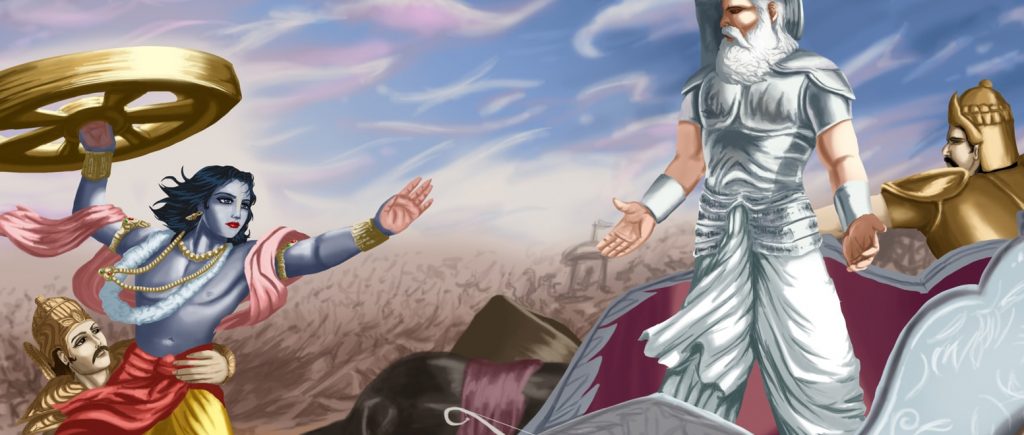
The main elements of a daily devotional practice include:
- Heart-centered prayer
- Kirtan or chanting meditation combined with active visualization
- Aarti-the offering of light – a brief ceremony that reaffirms the spirit of our devotional dedication
Karma Yoga – Dynamic Devotion
For the attainment of divine love, the Vedas state that there is only one rule and one prohibition that apply to bhakti yoga meditation. The rule is: “Always remember Radha Krishna.” The prohibition is, “Never forget Radha Krishna.”
This means that after our sitting meditation, our meditation should continue — while eating, sleeping, walking, working, talking, resting, and so on.
Wherever you are, all the time, whatever you are doing, remember your divine beloved and don’t forget Him! This simultaneous devotion and action is karma yoga. This state of devotional consciousness is cultivated over time with practice.
For example, in the old days street musicians with hand organs kept small monkeys. A monkey by nature is extremely active. How to make a monkey’s nature conform to sitting still, and that, too, in a confined space?

The musician’s technique was to first restrain the monkey with a 100-foot rope. If the monkey tried to go outside of this range, he was stopped. He thought, “Okay, I’ll jump around in a 100-foot area.”
When he was tied with a 50-foot rope he thought, “I went 100 feet yesterday, today I’m restricted to this much.” So he jumped around in a 50-foot area.
When the monkey was finally limited to only 1 foot of rope, he sat quietly, “Why should I drive myself crazy? I’ll just sit here.”
The human mind has this same monkey-like nature. It roams far and wide. Our goal is not to tame it’s active nature, but to train it to roam in a particular area. This is done by gently tying it with the devotional rope of love.
In sitting meditation we cultivate a feeling a devotional relationship with God. In active meditation we can continue this in three ways:
- Embed your intention — Every person has a mission that guides his life’s activities. For example, very few people like to work, but they do it because their mission is to support themselves or their family. While they are at work, although this motive is hidden deep in their mind, it still guides their decisions and actions.Similarly, when we firmly understand the purpose of our life is God-realization, this intention deeply embeds itself in the mind. If cultivated properly, this subconscious devotional intention remains in all our activities, even when we are sleeping.
- Feel divine presence — in sitting meditation we visualize and feel our relationship to God’s personal form. In activity, take hourly breaks for 30 seconds or a minute and with open eyes sense the presence of your worshipped form of God or Radha Krishna. Simply feel you are not alone. Imagine them near or far, sitting, standing or in any position, in any mood of love.
- Share your awareness — After visualizing God’s presence, either feel He is watching you or that you are showing Him what you are doing.
- Avoid wrong association — your associations and environment will affect your feeling of divine connection. Be mindful and avoid those situations that divert your devotional intention.
There is no restriction of time, place and activity for this remembrance. It can be done anywhere, at any time. You do not need to sit in a particular position or have closed eyes. This very simple practice will recall the blissful feelings of your seated meditation and help to stabilize your devotional experience.
Follow us on Facebook
Follow us on Twitter
Latest


Seven Vows and Steps (pheras) of Hindu Wedding explained
Views: 9,127 Indian marriages are well renowned around the world for all the rituals and events forming part of the...


Sari or Saree is symbol of Indian feminism and culture
Views: 7,364 One of the most sensual attires of a woman in India is undoubtedly the sari. It is a...


Atithi Devo Bhava meaning in Hinduism and India
Views: 7,129 Atithi Devo Bhava, an ancient line taken from the Hindu scriptures and was originally coined to depict a visiting person whose...


Sanskrit Is More Than Just A Method To Communicate
Views: 5,367 -By Ojaswita Krishnaa Chaturvedi anskrit is the language of ancient India, the earliest compilation of sound, syllables and...


Significance of Baisakhi / Vaisakhi
Views: 6,578 Baiskhi is also spelled ‘Vaisakhi’, and is a vibrant Festival considered to be an extremely important festival in...


Navaratri: The Nine Divine Nights of Maa Durga!
Views: 7,686 – Shri Gyan Rajhans Navratri or the nine holy days are auspicious days of the lunar calendar according...


History of Vastu Shastra
Views: 10,871 Vastu Shastra (or short just Vastu) is the Indian science of space and architecture and how we may...


Significance of Bilva Leaf – Why is it dear to Lord shiva?
Views: 10,521 – Arun Gopinath Hindus believe that the knowledge of medicinal plants is older than history itself, that it...


Concept of Time and Creation (‘Brahma Srishti’) in Padma Purana
Views: 10,782 Pulastya Maha Muni affirmed to Bhishma that Brahma was Narayana Himself and that in reality he was Eternal....


Karma Yoga – Yog Through Selfless Actions
Views: 9,676 Karma Yoga is Meditation in Action: “Karma” means action and “yoga” means loving unity of our mind with...

